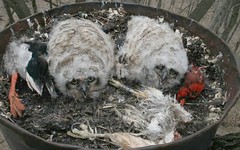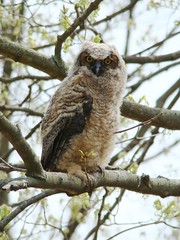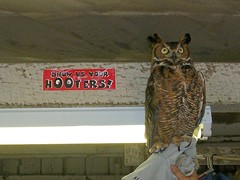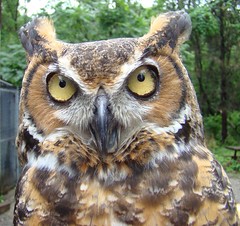GREAT HORNED OWL
Bubo virginianus
(Junior, the owl who thought I would make a good mate)
The great horned owl is found in just about any habitat you could name in North America, from the Arctic tundra to tropical rainforest, from desert to suburban backyards.
Though adaptable to many habitats, they prefer open and secondary growth forest, and agricultural areas.
It is estimated that this owl nests in EVERY COUNTY in the US.
Though they can be easily mistaken for Magellanic Horned Owls and other eagle-owls, they are allopatric.
There are a number of sub-species that have been named:
Click here for a list.
Description:
- Size: 46-63 cm (18-25 in)
- Wingspan: 101-145 cm (40-57 in)
- Weight: 910-2500 g (32.12-88.25 ounces)
- The female is larger than the male.
- Large owl.
- Prominent ear tufts widely spaced on head (called plumicorns).
- Body brown and gray with dark barring.
- Throat white.
- Orange facial disk outlined in black.
- Eyes yellow.
- Bill dark.
- Some forms pale gray to white.
Great horned owls do not build a nest of their own. They will use the nests of hawks, eagles, and crows. They will also use broken snags of trees, and will readily use man-made "nest cans".
Courtship begins in mid-December, and egg-laying begins in mid-January. So if you have local GHOW's, start listening now for their courtship hoots!
Voice: ho-ho-hoo, hoo hoo
Male's voice is deeper than the female's.
(Very ATYPICAL nest can...two owlets, half of a mallard, a whole cardinal, and half of a red-shouldered hawk, complete with band. The best band recovery I have heard yet.)
Number of eggs laid can be 1-5, with the norm being 3. (5 is very rare)
Incubation lasts from 27 to 33 days.
Either the male or female will brood almost continuously for 2 weeks, until the chicks can thermo-regulate themselves.
(Brancher....when the babies are strong enough to perch on a branch (6 weeks old), but still not ready to fly away yet)
The offspring can still been seen begging for food in late October (5 months after leaving the nest) and most do not separate from their parents until right before they start to reproduce for the next clutch (usually December). Birds may not breed for another year or two, and are often vagrants ("floaters") until they mate, establish their own territories, and settle down.
While young GHOW can have many predators, adult GHOW have almost no natural enemies.Occasionally, Northern Goshawks and other great horned owls are the only natural things they need to worry about.
Unnatural causes of death:
Shooting.
Trapping.
Poisoning.
Electrocution.
Hit by cars.
HUNTING:
Hunting is done on a perch, waiting. Then a swoop-and-grab.
There is a wide variety to a GHOW diet.
Small to medium mammals: Mice, rats, squirrels, flying squirrels, voles, bats, marmots, shrews, rabbits, hares, woodchucks, SKUNKS and sometimes even PORCUPINES. (The great horned owl is one of very few predators who will eat skunks)
Repiles, fish and amphibians.
Other raptors up to the size of Snowy Owls.
The largest prey I have heard of taken by a GHOW: Great Blue Heron. WOW.
In northern regions, if a GHOW catches prey that is too big to eat in one sitting, they will allow it to freeze and "thaw" it out later by incubating it.
Great horned owls have 500 pounds per square inch crushing power in their talons. For reference, an adult male HUMAN has about 60 pounds per square inch crushing power in his hands. WOW.
FUN FACTS:
Great horned owls have eyes about the size of a humans, and their vision is binocular. Their eyes are immobile within the bony sockets, so instead of turning their eyes, they turn their heads....about 270 degrees around. (Compared to us pitiful humans only managing 180)
Due to the size of their eyes in comparison to the size of their brains, owls are able to see in near-darkness.
An owl's hearing is as good, if not better, than its vision. Ears are off-set, usually one being much higher (and larger) than the other, giving them better depth perception in their hearing. We humans can tell if something is left or right of us, but owls can tell the difference between up and down, too.
A great horned owl can take prey up to 3 times or more of its weight. (Keep those cats indoors!)
Though they do not strictly "migrate", young banded birds have been found over 150 miles away from the place of their birth. Northern GHOW will move farther south in the winter months, while southern owls do not move.
Great horned owls are long-lived: In the wild, banded birds have been found 28 years after banding, and the record captive GHOW lived to be 45.
Thanks to their soft flight feathers and a specialized edge on the front of their wings, owls have silent flight.
.
"I disapprove of....well, everything you just said."






12 comments:
Loved the fun facts!!
The Great Horned Owls are calling and hooting over here in Ferndale, WA. Thanks for the info.
Very interesting facts. I learned a ton of stuff on this owl that I had not know previously.
BTW: I am going to a spot this weekend where there have been sightings of a snowy owl. I instantly thought of you!! It would be the first owl I have ever seen so I am keeping my fingers crossed.
Up here on the mountain we do not have Great Horned Owls. But we do have Barred Owls and Long-eared Owls. of course, I do not see them, but I hear them in the wee hours. The Short-eared Owls are staring to come back too. I saw one a few weeks ago.
Right now these guys are hooting like crazy in my suburban neighborhood. A couple of times I've heard the call of the young fledglings begging to be fed. That's a creepy goosebumpy sound.
You have to love these birds. We hear them often and are thrilled every time. Thanks for the good information about them.
love owls. Never ever get to see them. I've heard what had to have been two GHOW's hooting their heads off in the early morning . . . back when I used to take better care of myself and actually went for walks everyday. :) It was magical -- they were calling across the valley.
Excellent profile.
I heard a pair hooting in the neighborhood early last Saturday morning. Every so often one will hoot from one of the trees in our front yard--that's really cool. I love these owls too.
Hi Susan, This is my first visit to your blog. I read your comments on Jayne's blog and thought I would check your site out. NEAT info on Owls. I love their eyes!!!! Thanks!
Excellent profile, Susan! I love owls (who doesn't?), but I've never seen one in the wild.
Loved the story about Junior, by the way!
~Kyle
I loved this! These owls are amazing. And that disapproving owl face at the end is priceless. Thank you for such a great fact filled entry on these wonderful birds!
Post a Comment